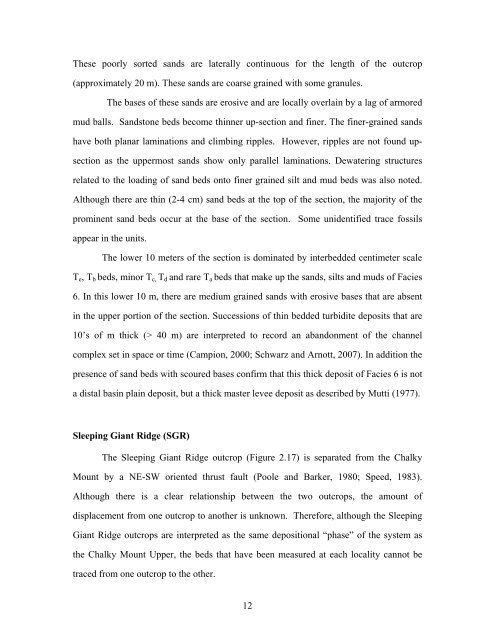Copyright by Nysha Chaderton 2009 - The University of Texas at ...
Copyright by Nysha Chaderton 2009 - The University of Texas at ...
Copyright by Nysha Chaderton 2009 - The University of Texas at ...
You also want an ePaper? Increase the reach of your titles
YUMPU automatically turns print PDFs into web optimized ePapers that Google loves.
<strong>The</strong>se poorly sorted sands are l<strong>at</strong>erally continuous for the length <strong>of</strong> the outcrop<br />
(approxim<strong>at</strong>ely 20 m). <strong>The</strong>se sands are coarse grained with some granules.<br />
<strong>The</strong> bases <strong>of</strong> these sands are erosive and are locally overlain <strong>by</strong> a lag <strong>of</strong> armored<br />
mud balls. Sandstone beds become thinner up-section and finer. <strong>The</strong> finer-grained sands<br />
have both planar lamin<strong>at</strong>ions and climbing ripples. However, ripples are not found up-<br />
section as the uppermost sands show only parallel lamin<strong>at</strong>ions. Dew<strong>at</strong>ering structures<br />
rel<strong>at</strong>ed to the loading <strong>of</strong> sand beds onto finer grained silt and mud beds was also noted.<br />
Although there are thin (2-4 cm) sand beds <strong>at</strong> the top <strong>of</strong> the section, the majority <strong>of</strong> the<br />
prominent sand beds occur <strong>at</strong> the base <strong>of</strong> the section. Some unidentified trace fossils<br />
appear in the units.<br />
<strong>The</strong> lower 10 meters <strong>of</strong> the section is domin<strong>at</strong>ed <strong>by</strong> interbedded centimeter scale<br />
Te, Tb beds, minor Tc, Td and rare Ta beds th<strong>at</strong> make up the sands, silts and muds <strong>of</strong> Facies<br />
6. In this lower 10 m, there are medium grained sands with erosive bases th<strong>at</strong> are absent<br />
in the upper portion <strong>of</strong> the section. Successions <strong>of</strong> thin bedded turbidite deposits th<strong>at</strong> are<br />
10’s <strong>of</strong> m thick (> 40 m) are interpreted to record an abandonment <strong>of</strong> the channel<br />
complex set in space or time (Campion, 2000; Schwarz and Arnott, 2007). In addition the<br />
presence <strong>of</strong> sand beds with scoured bases confirm th<strong>at</strong> this thick deposit <strong>of</strong> Facies 6 is not<br />
a distal basin plain deposit, but a thick master levee deposit as described <strong>by</strong> Mutti (1977).<br />
Sleeping Giant Ridge (SGR)<br />
<strong>The</strong> Sleeping Giant Ridge outcrop (Figure 2.17) is separ<strong>at</strong>ed from the Chalky<br />
Mount <strong>by</strong> a NE-SW oriented thrust fault (Poole and Barker, 1980; Speed, 1983).<br />
Although there is a clear rel<strong>at</strong>ionship between the two outcrops, the amount <strong>of</strong><br />
displacement from one outcrop to another is unknown. <strong>The</strong>refore, although the Sleeping<br />
Giant Ridge outcrops are interpreted as the same depositional “phase” <strong>of</strong> the system as<br />
the Chalky Mount Upper, the beds th<strong>at</strong> have been measured <strong>at</strong> each locality cannot be<br />
traced from one outcrop to the other.<br />
12
















